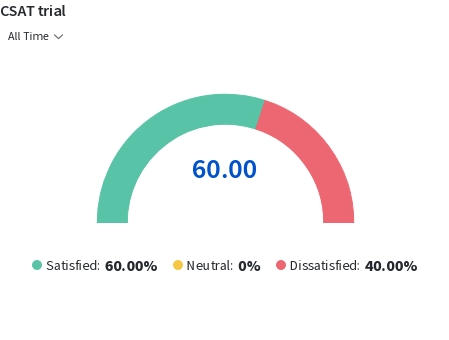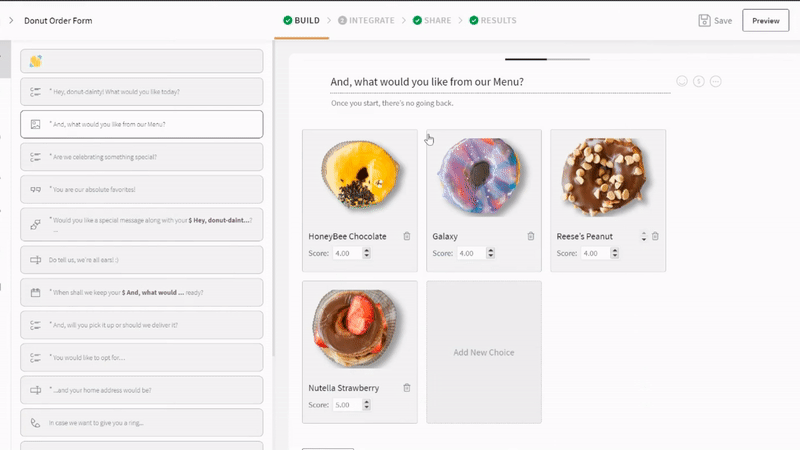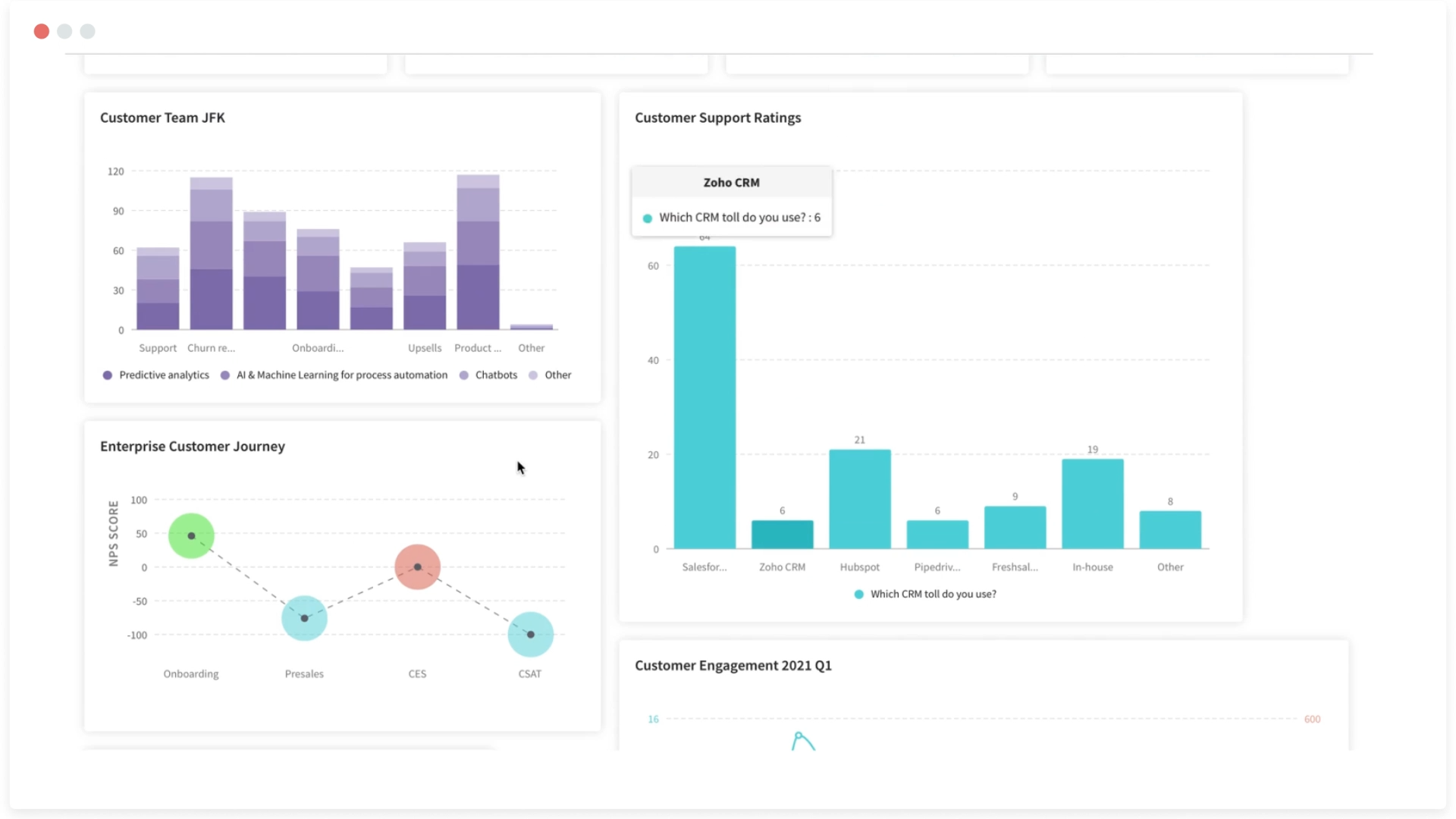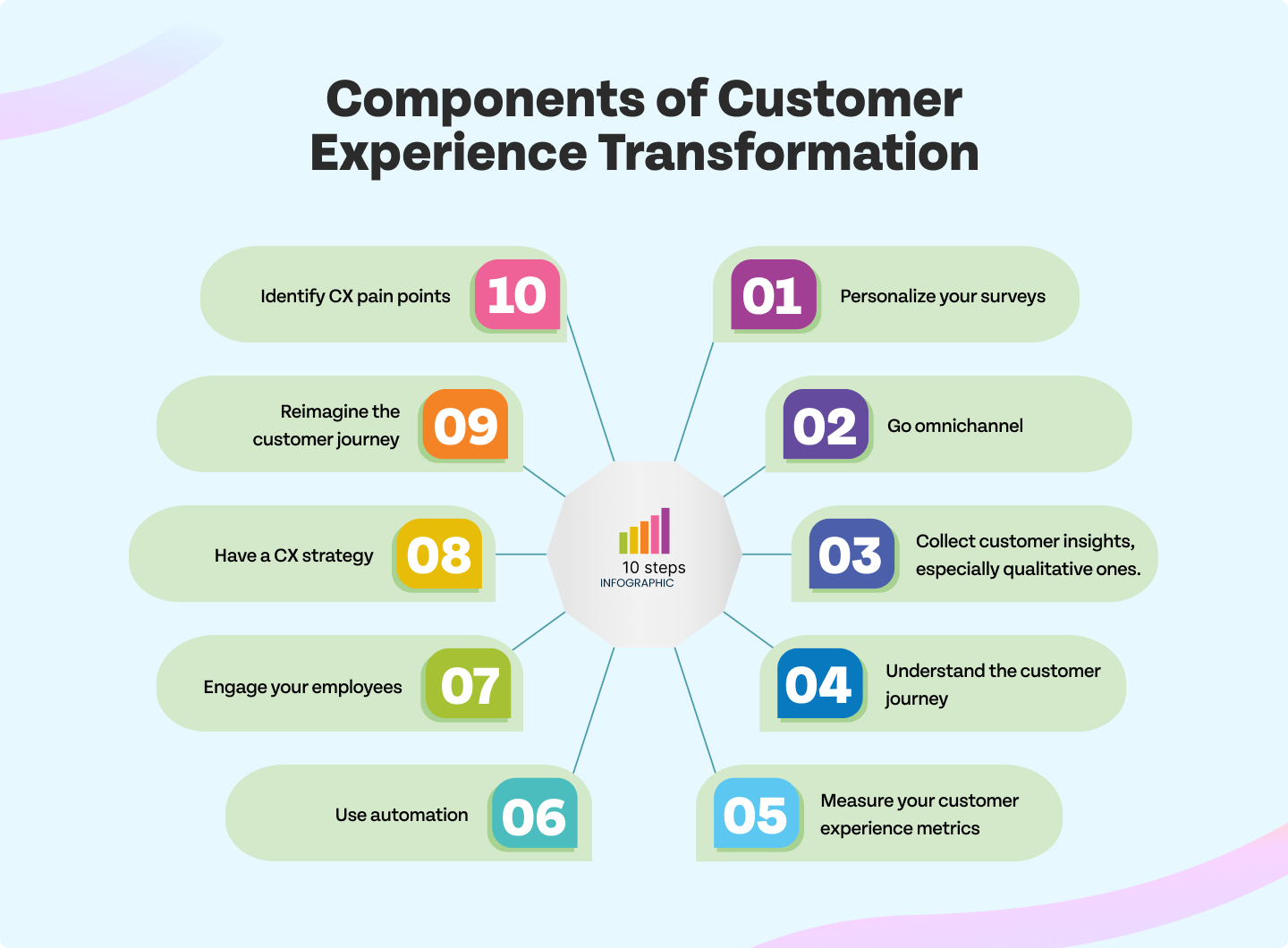Customer Experience
Mastering the Art of Customer Experience Transformation: A Comprehensive Guide
Article written by Kate Williams
Content Marketer at SurveySparrow
11 min read
19 September 2025

In our fast-paced, customer-focused world, it’s clear: customer experience (CX) is everything. Businesses everywhere are realizing the importance of putting customers first. That’s where customer experience transformation comes in.
Understanding Customer Experience Transformation
Customer experience transformation, also known as CX transformation, is a strategic effort businesses make to change how they interact with customers. This involves improving upon every customer interaction – which leads to superior customer experiences, happier customers, more loyal customers, and ultimately, more business growth.
But what exactly does customer experience transformation involve? And how can businesses master it? This guide will explain everything you need to know.
“Effective customer-experience transformations require a clear vision and a customer-centric, ambitious articulation of goals.” – Tjark Freundt
Why Customer Experience Transformation is Crucial
The customer’s journey with a brand extends beyond purchasing a product or a service. It includes all of the ways they connect with the brand, like customer service, online platforms, or face-to-face meetings. These interactions shape how customers see the brand, which affects whether they’ll buy from it again and if they’ll tell others about it.
CX transformation – especially of the digital kind – can be a key differentiator in a time when lots of products and services seem the same. By providing exceptional customer experiences, businesses can drive customer loyalty, foster brand advocates, and gain a competitive edge.
The Six Pillars of Customer Experience Transformation
There’s no one-size-fits-all approach to customer experience transformation. But the following six pillars serve as a solid foundation for any CX transformation strategy:

1. Customer-Centric Culture
A customer-centric culture is the backbone of CX transformation. To bring that about, you need to embed a customer-first mindset throughout the organization, from top management to front-line employees. To foster this culture, businesses must prioritize customer needs, provide ongoing training, and reward customer-focused behaviors.
2. Data-Driven Insights
Data is the key to unlocking customer experience transformation. Businesses can gain insights into customer needs, preferences, and pain points by leveraging data from customer feedback, social media, and other sources. These insights help organizations identify areas for improvement and make informed decisions about their CX strategy.

3. Seamless Omnichannel Experiences
Today’s customers interact with brands across multiple channels, including websites, mobile apps, social media, and brick-and-mortar stores. A successful digital CX strategy ensures customers receive a seamless and consistent omnichannel experience across all these touchpoints. This involves optimizing user interfaces, streamlining processes, and ensuring consistent messaging.

4. Personalization
Let’s talk about personalization—it’s a big deal for making every customer experience feel special. When you customize your products, services, and messages to fit each customer’s preferences, it makes their experience stand out. They feel like you really get them, and that’s what keeps them coming back for more.

5. Continuous Improvement
CX transformation is an ongoing process. To stay ahead of the competition and adapt to changing customer expectations, businesses must continuously gather feedback, analyze data, and iterate on their customer experience strategies.

6. Customer Transformation Framework
A robust customer transformation framework can guide your CX transformation journey. This framework includes the following stages:
- Assessment: Understand your current customer experience lifecycle, identifying gaps, and evaluating your organization’s readiness for transformation.
- Visioning: Here, you define the future state of your customer experience. What do you want your customers to feel when interacting with your brand? What changes are necessary to achieve this?
- Design: In this stage, you design the desired customer journey and customer experiences. This involves rethinking your processes, systems, and structures to align with your vision.
- Implementation: This stage involves bringing your designs to life. Whether it’s revamping your website, retraining your staff, or implementing new CX technologies, this is where you actualize your CX transformation.
- Measurement and Optimization: Finally, it’s crucial to continuously measure the impact of your changes and optimize your strategies. This could involve tracking customer satisfaction scores, Net Promoter Scores (NPS), or other relevant metrics and using these insights to refine your customer experience further.
A structured framework like this can ensure a systematic and effective approach to your customer experience transformation.
And with a tool like SurveySparrow, each stage can be greatly enhanced. SurveySparrow’s platform can help you assess current experiences through feedback surveys, measure the impact of your changes with analytics tools, and continuously optimize your strategies based on real-time data.
How Do You Transform Customer Experience?
Here are the 12 steps you need to follow in your CX transformation strategy:
- Assess your current customer experience: Gather customer feedback and data to understand your customers’ needs and pain points.
- Establish clear objectives: Define your vision, such as increasing customer loyalty or reducing churn.
- Clearly define roles and responsibilities: Specify the roles and responsibilities of each team member involved in the transformation.
- Provide a roadmap: Outline the steps and timeline for the transformation. Address potential challenges and how you plan to solve them.
- Demonstrate ROI: Show the ROI a CX transformation can provide, whether it aligna with your organization’s long-term vision.
- Design a customer experience roadmap: Conduct customer research and analysis, and adapt your CX initiatives accordingly.
- Secure necessary resources and budget: Define specific objectives and secure the resources and tools you’ll need. For instance, many businesses choose to outsource customer service in the Philippines to leverage its skilled workforce, cost efficiency, and ability to scale customer operations. This can free up internal resources while enhancing service quality.
- Involve stakeholders in the process: Ensure leadership teams and key employees actively engage in the process.
- Address organizational resistance to change: Communicate the value and benefits of CX transformation.
- Transform the business: Create cross-functional teams to consolidate customer insights, manage customer journeys, and implement CX initiatives.
- Continuously improve: Regularly assess market trends and competitor strategies.
- Measure and track success: Use key metrics to evaluate the success of your CX transformation.
Related: 7 ‘Old-School’ Strategies to Transform Your CX
How to measure the success of a CX transformation?
To measure the success of a Customer Experience transformation, you can use a combination of various CX metrics. Four key metrics to consider include:
- Net Promoter Score (NPS): Measures customer loyalty to a company.
- Customer Satisfaction (CSAT): Gauges customer satisfaction with a specific product, service, or sales experience.
- Customer Effort Score (CES): Measures the overall effort required to use a product or service.
- Churn Rate: Measures the percentage of customers who stop using a company’s products or services.
It’s important to gather up all of your customer experience metrics into one place. It’s how you keep things on track and identify areas for improvement. Tools like SurveySparrow can help you do just that, and more.
Empowering Your CX Transformation with SurveySparrow
While CX transformation may seem daunting, tools like SurveySparrow can make the journey smoother.
As an omnichannel experience management platform, SurveySparrow provides businesses with valuable insights into their customers’ needs and experiences. SurveySparrow’s easy-to-use platform allows you to collect customer feedback through engaging surveys and analyze this data to gain meaningful insights.
Additionally, SurveySparrow’s advanced features allow for segmentation and personalization, helping you design and deliver customized experiences that truly resonate with your customers. You can also automate your surveys, ensuring continuous feedback and real-time insights.
Sign up for SurveySparrow and start transforming your customer experience today.

Explore Deeper Customer Insights with SurveySparrow
A personalized walkthrough by our experts. No strings attached!
Customer Experience Transformation Examples
Need a customer experience transformation case study? Check out two great examples below:
Customer Experience Transformation: Case Study #1 📱
Company Name: Rainbow Communications
Industry: Telecommunications
Employee Size: 11-50
Plan: Enterprise Advanced
About the Company:
Rainbow Communications, a dedicated independent Internet Service Provider (ISP), is on a mission – to enrich rural communities by providing cutting-edge broadband services. Their strategy revolves around delivering state-of-the-art broadband technology and services at a competitive rate. This sets them apart as a trusted local provider committed to exceptional customer service.
Challenge:
Rainbow Communications faced a significant challenge in gathering and analyzing customer feedback efficiently.
While previously outsourcing customer surveys, they recognized the need to bring the surveying process in-house to enhance control and gain real-time insights. They also sought to improve customer service, service quality, and staff training by understanding customer sentiment at a more detailed level.
Use Case:
To tackle these hurdles, Rainbow Communications decided to streamline their survey process with SurveySparrow.
They reached out to their audience, including both residential and business customers, by sending out annual loyalty survey invitations via email. They popped a QR code into mailers for effortless survey access.
Additionally, they kept things snappy by sending short transactional surveys via email and text messages. This was done to gauge customer satisfaction with repairs and new installations.
Goals:
- Use Net Promoter Score (NPS) from their annual loyalty survey as a staff performance metric
- Identify opportunities for enhancing customer experience, service quality, and staff training.
- Gather information from transactional surveys to gauge the performance for all staff – providing insights into areas of improvement and training opportunities.
- Sought a comprehensive dashboard within SurveySparrow. This dashboard would provide insights into customer satisfaction regarding installation and repair
- Track metrics like average Customer Satisfaction, Service Satisfaction, and NPS Score.
- Allow segmentation of data by NPS disposition, revenue area, and the type of service (install or repair).
- Enable them to view all comments for the month, highlighting specific customer appreciations, employee shoutouts, and areas where CX could be improved.
- Use this data as a performance matrix for every employee.
- Facilitate training and management to continually enhance their services and better serve their rural communities.
Customer Experience Transformation: Case Study #2 🛵
Company Name: Hero Moto Corp Ltd
Industry: Motor Vehicle Manufacturing
Employee Size:1001 – 5000
Plan: Enterprise Advanced
About the Company:
Hero Moto Corp Ltd. is the world’s largest manufacturer of two-wheelers, based in India. In 2001, the company achieved the coveted position of being the largest two-wheeler manufacturing company in India, and also, the ‘World No.1’ two-wheeler company in terms of unit volume sales in a calendar year. They recently launched their electric vehicle segment “VIDA”.
Use Case:
Running customer feedback surveys for Hero and VIDA to understand customer opinion and the areas of improvement. Moreover, an integration with Azure Data Factory was necessary.
Hero wanted to understand the customer experience at different touchpoints – mainly during post-purchase. They had never used a platform specifically to gauge customer experience for their two products VIDA and Hero, and liked how SurveySparrow helped them with data drill-down based on Stores, Regions, and Zones.
Goals:
- Easy survey creation with minimal effort.
- Better understanding of their customer feedback in real-time based on touchpoints (post-purchase).
- Data drilldown based on regions and zones.
Embracing these changes while understanding the risks and challenges they pose is the key to thriving no matter what transformations are around the next corner. – Bernard Marr
Wrapping Up
Customer experience transformation is not just about changing certain business operations. It’s about shifting your entire organizational mindset to focus on the customer, using data-driven insights to make informed decisions, and continuously striving for improvement. It’s about creating a culture that values customer feedback and uses it to drive innovation and growth.
In today’s competitive business landscape, customer experience transformation isn’t just a nice-to-have; it’s a must-have. It’s the key to unlocking customer loyalty, fostering brand advocacy, and driving business success.
And while the journey to customer experience transformation may seem challenging, you’re not alone. With tools like SurveySparrow, you can gain the insights and capabilities you need to successfully navigate this journey and deliver exceptional experiences that set your brand apart.
Are you ready to take the next step in your CX transformation journey?

Make your customers feel heard. Turn feedback into loyalty with SurveySparrow's CX platform.
Kate Williams
Related Articles

Customer Experience
Customer Journey & SEO: Understanding the Impact on Marketing Success
12 MINUTES
9 February 2024

Customer Experience
Top 10 Inevitable Trends Shaping Customer Experience in Banking
8 MINUTES
22 June 2023

Customer Experience
All You Need To Know About Customer Retention - The Ultimate Guide
13 MINUTES
10 January 2020

Customer Experience
Top 9 Customer Experience Trends for 2024 and 2025
9 MINUTES
24 July 2023

